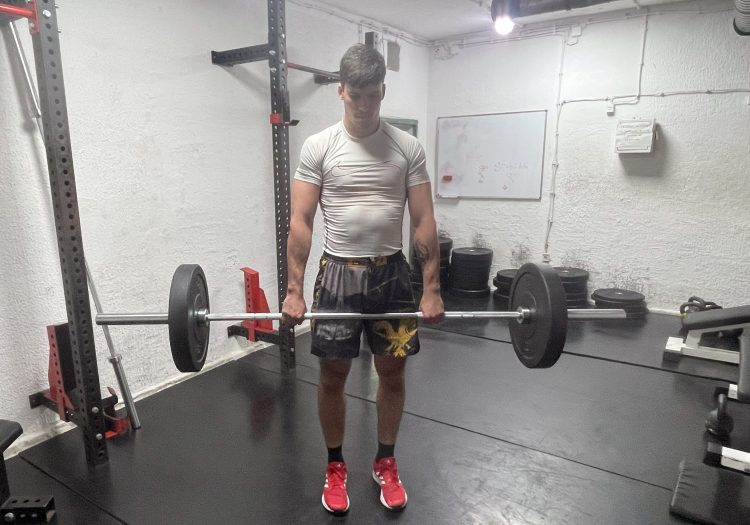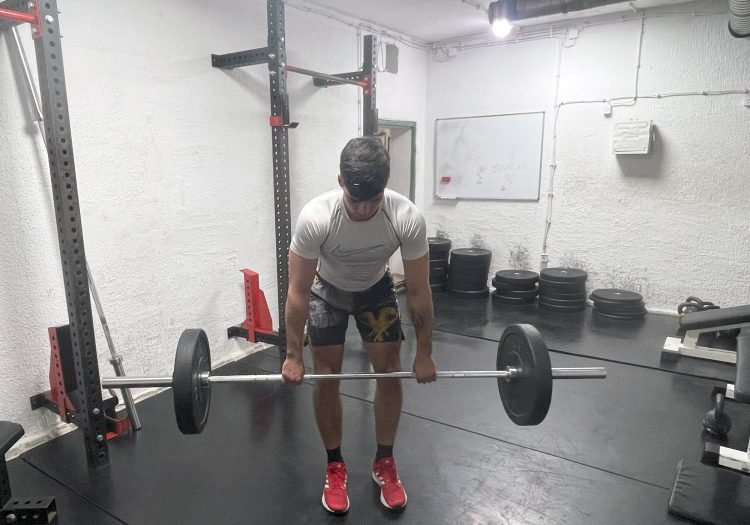The bottom half deadlift is an excellent deadlift variation that can help you overcome sticking points in the bottom half of your range of motion (ROM). It can also promote hypertrophy because your muscles are under constant tension in the lengthened position. (1)
Last year, when I was chasing a new deadlift PR, I gave bottom-half deadlifts a shot. With strategic programming, these targeted lifts proved instrumental in overcoming sticking points and boosting my overall deadlift by approximately five percent over a two-month focused training block.
How To Do a Bottom Half Deadlift
Here is a step-by-step guide to perform this exercise:
Step One — Assume the Starting Position
Stand upright with a shoulder-wide grip in front of a barbell. Hinge at the hips and grab the barbell with an overhand or mixed grip. Maintain a flat back, engaged core, and forward gaze. Position your shoulders over the bar with your hips slightly above knee level.
Level Up Your Fitness: Join our 💪 strong community in Fitness Volt Newsletter. Get daily inspiration, expert-backed workouts, nutrition tips, the latest in strength sports, and the support you need to reach your goals. Subscribe for free!
Pro Tip: Engage your lats by pulling your shoulder blades down and back. This action stabilizes your upper body and helps maintain a flat back throughout the lift.
Step Two — Lift the Barbell off the Floor
Extend your ankles, knees, and hips to lift the barbell off the floor. Stop when the barbell reaches your knee level.
Pro Tip: Think about pushing the floor away with your feet rather than just focusing on hinging at the hips. This optimizes lower body engagement, reducing strain on your lower back.
Step Three — Lower the Barbell Toward the Floor
Slowly lower the barbell toward the floor by reversing the motion. Maintain control throughout the descent to maximize muscle engagement and prevent injury.
Pro Tip: Control the descent to fire up your hamstrings and glutes.
“I am a big fan of block periodization. When it comes to the reps, typically for the deadlift, I don’t like to go higher than eight reps. Anything beyond that tends just to be a ton of cardio and endurance. We will go down in reps as we increase the intensity over time. Regarding frequency, I do pull [workouts] and some sort of deadlift thrice a week. As far as the sets go, you want to stay in the three to five range,” recommends strength coach and multi-sport athlete Joey Szatmary.
Muscles Worked
The primary muscles are the glutes, hamstrings, quads, and erector spinae. The secondary muscles include your core, forearms, upper back, lats, and adductors to a certain extent.
Benefits of Bottom Half Deadlift
Here are the most notable benefits of doing bottom-half deadlifts.
Enhanced Strength at Weak Points
Biomechanically, the bottom half is the most challenging part of a deadlift. That’s why it’s important to train this movement pattern in isolation.
Greater Posterior Chain Activation
The bottom half deadlift is an excellent way to load your posterior chain muscles, especially when you don’t rest the bar on the floor between reps. The bottom position offers a deep glutes and hamstrings stretch, maximizing hypertrophy.
Enhanced Core Stability
The bottom half of the deadlift requires substantial core activation. This will increase the isometric strength of your hip and abdominal muscles, leading to better stability and balance and a reduced chance of injuries. (2)
Variations and Alternatives: Bottom Half Deadlift
Here are the bottom-half deadlift variations and alternatives you should consider adding to your workout:
Deficit Deadlift
Deficit deadlift variation allows you to achieve a deeper posterior chain stretch.
Steps:
- Place a weight plate or an elevated surface like an aerobic stepper on the floor.
- Then, position a barbell over the elevated surface.
- Assume a shoulder-width stance on the elevated surface.
- Bend down, grab the barbell with a pronated or mixed grip, and ensure your back is flat, core activated, and your eyes are looking straight ahead.
- Lift the barbell to a lockout.
- Reverse the motion to return to the starting position.
- Repeat for the desired amount of reps.
Pro Tip: Keep your hips low and your chest up as you initiate the lift. This helps maintain proper leverage and reduces strain on your lower back. Additionally, engage your lats by pulling the bar towards you, stabilizing your upper body throughout the movement.
Paused Deadlift (Bottom Focus)
The paused deadlift allows you to address and strengthen specific weaknesses within your deadlift ROM. Focus on pausing just before the bar touches the ground, but you can focus on any point in your ROM based on your preference and what you are trying to improve.
Steps:
- Get into the starting deadlift position.
- Lift the barbell off the floor by extending your ankles, knees, and hips.
- Pause for a few seconds when the bar reaches your mid-shin level (assuming that is your stick point).
- Continue to lift the barbell to the top position.
- Lower the barbell to the floor and repeat the whole sequence again.
Pro Tip: Hold your breath during the pause for optimal thoracic pressure. Vary the pause duration to challenge your muscles and improve adaptability.
Romanian Deadlift (RDL)
It is one of the best deadlift variations for loading the posterior chain muscles, such as glutes, hamstrings, and lower back.
Steps:
- Stand upright with a shoulder-wide stance while holding a barbell against your thighs using a pronated grip.
- Lower the barbell by hinging at the hips and pushing them back.
- Pause at the bottom of your range of motion.
- Extend your hips to return to the starting position.
Pro Tip: Push your hips back as if trying to shut a car door. Ensure a slight bend in the knees throughout the movement to keep the focus on your hamstrings and glutes and protect your lower back.
Read more build a powerful posterior chain with Romanian deadlifts, or RDLs for short.
Good Mornings
Good mornings are a hip-hinge exercise that targets your glutes, hamstrings, and erector spinae muscles.
Steps:
- Rack a barbell at shoulder height in a squat rack.
- Position the barbell on your upper back, unrack it, and take a step or two back.
- Slightly bend your knees and maintain the position throughout the exercise.
- Ensure your back and neck are neutral and your eyes are looking straight ahead.
- Bend at the hips while maintaining slight knee flexion.
- Lower until your torso is almost parallel to the ground.
- Hold the bottom position for one second.
- Reverse the motion to return to the starting position.
Pro Tip: Place the bar snugly across your upper traps to avoid sliding. This ensures stability and reduces strain on your neck and spine. Focus on moving your hips back to intensify hamstring and glute activation while preserving spinal alignment.
FAQs
Are half deadlifts effective?
Half deadlifts are excellent for targeting and strengthening weaknesses within your deadlift ROM.
Should I deadlift fast or slow?
A slower rep cadence will increase the total time your muscles are under tension, which can promote hypertrophy and help you drill the movement mechanics. On the contrary, a faster rep tempo is better for strength and power development.
How often should I incorporate bottom-half deadlifts into my training?
Consider adding bottom-half deadlifts to your routine if you struggle in the bottom half of the deadlift. How often you do them depends on your form and efficiency.
Wrapping Up
The bottom-half deadlift is a valuable tool for overcoming the hardest deadlift sticking points, which are usually in the bottom half of the ROM. I love doing bottom-half deadlifts without touching the bar to the floor because partial reps in the most stretched position have been shown to promote hypertrophy.
Also, occasionally, working within a partial range of motion can help keep your routine interesting. In the comments below, let me know what you think about this deadlift variation.
References:
- Pedrosa GF, Lima FV, Schoenfeld BJ, et al. Partial range of motion training elicits favorable improvements in muscular adaptations when carried out at long muscle lengths. Eur J Sport Sci. 2022;22(8):1250-1260. doi:10.1080/17461391.2021.1927199
- Huxel Bliven KC, Anderson BE. Core stability training for injury prevention. Sports Health. 2013;5(6):514-522. doi:10.1177/1941738113481200
Relevant Articles:
- Build Strength and Size With The 15 Best Deadlift Variations
- Deadlift Form 101: How to Lift More Weight Safely
Interested in measuring your progress? Check out our strength standards for Good Morning, Deadlift, Romanian Deadlift, and more.










